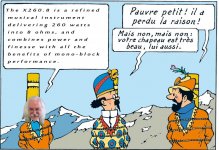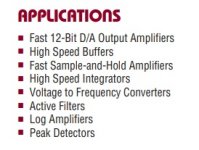Is that what an amplifier should be, a fine musical instrument?
It is sacrilege. I propose that we proceed with the immediate execution of Papa Nelson.Is that T bait? 😉
Attachments
Last edited:
In the realm of anecdote, my friend in CA so likes his new X260.8 Pass power amps he's just splurged on a factory recon set of preamps as well. With phono and line stage that's 5 boxes. I am mildly jealous.
Oh and Nelson is right, Apogees are fine when you get medieval on them 🙂
Medieval? 😛
Nothing wrong therewith. 😀
All those electrolytics may dominate the feedback loop response of the associated regulator, no?
Why would you assume that Mark?
Note 600 Ohm load drive definitely not designed for audio.
Really?
In what other application is 600 ohms important? If the unit can also drive 500 ohms or lower why don't the manufacturers specify the value?
Do you know where the 600 ohm value came from? It was not picked out of the air!
As to what an opamp is you are correct in that Analog Devices tries to seperate them from op amps. However the fellow (Ragazzini) who invented the term opamp in 1944 used it to mean an amplifier that could provide a function by a simple operational expression. The inamps as they are called do exactly that.
As to Analog Devices not making products for audio, that was their marketing decision. To deride folks who produce quality products in great quantities is silly. They have their own marketing strategies.
As to others who do design for audio applications, the National Audio Handbook should make it clear their marketing stratigies did include making products specifically for audio use.
national :: dataBooks :: 1976 National Audio Handbook : Free Download, Borrow, and Streaming : Internet Archive
BTY if I have the chance when at the office I will scan in some of the business cards from IC manufacturing folks who specialize in audio products including many opamps.
Bill, you still gotta have way more than five fingers on that hand of yours! 😉
Last edited:
Really?
Ed, you said it meant it was designed for audio "ground up". In this case that is certainly not true, the margins are too low in large quantity audio. LT also was interested in primarily high margin products. The 600 Ohms is merely for historical interest (back then many guys went to school in the 60's) and maybe catch some incidental business. It could have been 1k or maybe 500 Ohms but what number do you remember? I had several non-audio instruments that were 600 Ohms.
Read the LT1122 data sheet, no mention of audio, not even as an I to V on the then popular multi-bit DAC's. Even in 1988 that socket was at most 50 cents.
Attachments
National's LM381 would be one example.
With 0.1% distortions (and other issues, pulse response large overshooting, asymmetrical large signal response, etc...), LM381 was one of the op amps that created the audio "eight leg bad" legend. Not a silicon problem, but a brain problem, for those trying to use before understanding its limitations.
When I was 19 I built one of the RIAA amps from that handbook. I can't recall the exact part, but apparently it was designed for phono amps (and by implication NAB tape head amps) so it may have been the LM381. Tt had a very annoying hiss that I could never get rid of - a friend who also built one had the same problem. I guess it was a decoupling issue (or a parasitic OPS - some of the newer Natsemi devices showed a Zobel on the output to ground).
LM381 pdf, LM381 description, LM381 datasheets, LM381 view ::: ALLDATASHEET :::
LM381 pdf, LM381 description, LM381 datasheets, LM381 view ::: ALLDATASHEET :::
With 0.1% distortions (and other issues, pulse response large overshooting, asymmetrical large signal response, etc...), LM381 was one of the op amps that created the audio "eight leg bad" legend. Not a silicon problem, but a brain problem, for those trying to use before understanding its limitations.
I think everyone was still feeling their way forward with this opamp stuff in 1976 until the 5534 came along. The 741 (JC's favourite part 😉 ) wasn't even 10 years old and the 709 was still merrily blowing up every time you looked at it sideways. The 356 family was also a big step forward for GP opamps.
Just looked - the 5534 SMD is going for 30 pennies here from RS - will be the same $ price in the US. Get it in China from one of the big disti's like Avnet or WPI and it will be half to 2/3rd below that in high volume (100k+ drop shipments).
When I was still in the industry, Philips got out of it because the margins were so low and that was 15 years ago.
When I was still in the industry, Philips got out of it because the margins were so low and that was 15 years ago.
So it’s very difficult to tell the differences in blind testing...
Have you tried the various methods of blind testing yourself? Its about as Jakob says. A/B is much easier than ABX, which is an empirical finding about human perception testing, not a theory.
When I sorted PMA's opamp recording files, it was to find a suitable pair to ABX with. It was much easier to sort them in order of distortion by ear than it was to ABX two of them by ear (it was very difficult to sort them from recordings though, and I gave up before comparing the last one at the bottom of the list with the others).
However, I did PM PMA with the sort order before his answers were revealed, so he gave me credit for that. The sorting was done blind of course, no other way.
Why would you assume that Mark?
I said 'may' because sometimes it can be an issue. The regulator regulates the output and a significant enough pole there can affect loop bandwidth. As a result regulator PSRR may be reduced. There may be other effects, some may be intentional. Just checking to see what the designer thought 🙂
Last edited:
Follow the Data sheet recommendations and you should not have a problem.
What makes you assume use of an integrated regulator rather than discrete?
If the equipment allows the owner to gain pleasure from listening then all is good. Wayne and Nelson have spent many years coming up with amplifiers to meet that goal. We shall see how my friend likes them.Impressive range of amplifiers and I am sure they will be very good. However, in the brochure, these amplifiers are called 'fine musical instruments'.
Is that what an amplifier should be, a fine musical instrument? And does it make the owner that plays music through it a distinguished musician?
Medieval? 😛
Nothing wrong therewith. 😀
The Duetta sigs he has do seem to need a lot more power than the specs would infer. That or he's going deaf which is also possible. He claims his girlfriend no longer puts in ear plugs when he plays music (which is a step up from wife in the kitchen stories 🙂 )
Nice article.
When did Jim Williams join LT.
Hans
Ed, you said it meant it was designed for audio "ground up". In this case that is certainly not true, the margins are too low in large quantity audio. LT also was interested in primarily high margin products. The 600 Ohms is merely for historical interest (back then many guys went to school in the 60's) and maybe catch some incidental business. It could have been 1k or maybe 500 Ohms but what number do you remember? I had several non-audio instruments that were 600 Ohms.
Read the LT1122 data sheet, no mention of audio, not even as an I to V on the then popular multi-bit DAC's. Even in 1988 that socket was at most 50 cents.
Really, what non audio instruments were 600 ohms and why? Could just be the same reason.
So neither Analog Devices or Linear Technologies made specific audio parts. That was never the issue. Neither did Intel, we could name lots of folks whose marketing was focused on other markets.
Bill seemed to think there were five or less audio opamp designs. Easily disproven. Kind of curious if he will be good enough to post an image of his hand! 😉
With 0.1% distortions (and other issues, pulse response large overshooting, asymmetrical large signal response, etc...), LM381 was one of the op amps that created the audio "eight leg bad" legend.
I would hardly call it an op-amp. Let's be clear by designed for audio I was not considering commodity parts. I meant premium parts with the implication that something different was done just for audio. I'm waiting for evidence that someone spent $100,000 for a new mask set to get rid of some veil, or get a more liquid midrange. As far as I can tell the parts for audio are sold on price and specs not bling.
Take for instance the LT1115 (which is a rebrand of the LT1028) did they remove the problematic Ib comp which compromises noise for MM, no.
Really, what non audio instruments were 600 ohms and why? Could just be the same reason.
The Quan-Tech 420 noise source used in physics and medical research as a true calibrated Gaussian noise source.
- Status
- Not open for further replies.
- Home
- Member Areas
- The Lounge
- John Curl's Blowtorch preamplifier part IV

